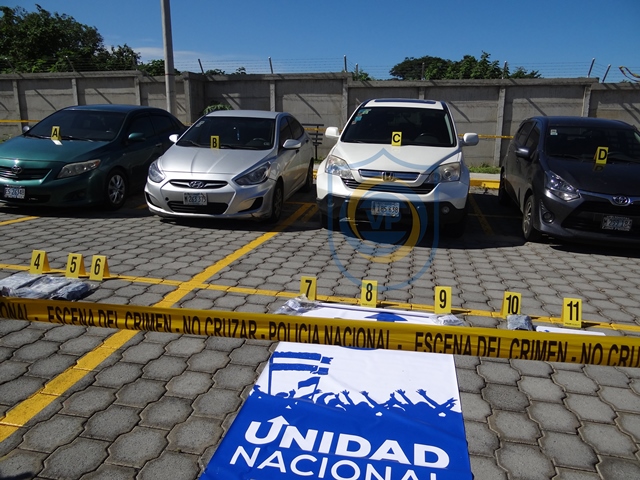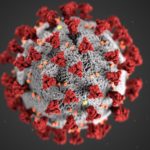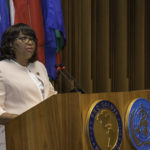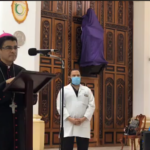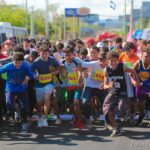A hunger strike staged inside the Parish of St. Michael the Archangel in Masaya has led to a tense standoff between the Nicaraguan government, led by Daniel Ortega, and the Catholic Church.
The protesters demand the release of over 100 people that the Ortega-Murillo authorities have classified as common criminals. However, the Civic Alliance for Justice and Democracy, one of the leading opposition coalitions in Nicaragua, disputes the official account. As of September, the Alliance reports at least 130 political prisoners in various penitentiaries around the country. An additional 112 individuals are reportedly missing.
The strikers include mothers, sisters, and wives of several political prisoners.
Fr. Edwing Román told the EFE wire service that he supported the women. “This Church will always open its doors to anyone in need. They have come here to pray and to stage a hunger strike. I am opening the doors to anyone that can help them,” said Román.
The strike is now entering its sixth day, and the government’s response has been two-fold. On the one hand, the Ortega-Murillo government has taken steps to force women to abandon their protest, by surrounding the church with police officers and cutting off water and electric service to the building. These actions have been documented through images and video, taken by journalists, citizens of Masaya, and by the people inside the church.
One video taken from within the church shows workers of the national water company, ENACAL, shutting down the water main.
Así le cortaron el agua a la Iglesia San Miguel de Masaya, con el objetivo de que los familiares de secuestrados políticos que hacen huelga de hambre para la liberación de los mismos, no tengan acceso al vital líquido. pic.twitter.com/ou4kaorMah
— Café con Voz (@CafeconVozNi) November 15, 2019
Other videos show the police deployment around the church, or document specific instances in which the police blocked access to the temple.
Iglesia San Miguel de Masaya totalmente rodeada de policías orteguistas.
El padre Edwin Román ha manifestado que se encuentran como rehenes.
##SosNicaragua pic.twitter.com/8zSxuL8CGJ— Hector Rosales (@Hector_RosalesA) November 15, 2019
On Friday, the police denied access to a delegation of priests sent by the Archdiocese of Managua. The priests were stopped about a block away from the parish, according to a Facebook post published in the Archdiocese’s official page
On the other hand, the administration and its official media have all but ignored the protest in Masaya. Indeed, the closest to an official acknowledgement of the situation came on Monday, during Vice-President Rosario Murillo’s daily noon address. Murillo said that “Peace is not to be taken lightly.”
Con la paz no se juega.
Murillo’s “con la paz no se juega” dictum has been turned into a hashtag and rallying cry for Ortega-Murillo sympathizers in their protests against the Catholic Church. For example, this tweet, from an Ortega-Murillo sympathizer account, states that the Nicaraguan people “are tired of going to churches only to find a coup-mongering circus”
✊🏾✝️ El pueblo Nicaragüenses ya está cansado de ir a las iglesias y encontrar un circo de golpista!!! #NoEraAguaEranArmas#ConLaPazNoSeJuega#NoPudieronNiPodran pic.twitter.com/pZa5VB86Mu
— FITO Marenco Abea (@FITOMarencoJS) November 19, 2019
Police Arrest UNAB Activists in Masaya
In addition to denial of access, a physical blockade, and the shutting down of power and water, the police in Masaya arrested 16 people, including 13 members of the Blue and White National Unity coalition (UNAB, by its Spanish acronym). The official version is that the arrests are a mayor crackdown on terrorism.
Commissioner Victoriano Ruiz made the announcement during a press conference on Monday.
According Ruiz, police “captured 16 criminal terrorists, who were traveling in four vehicles, led by Ivania del Carmen Alvarez Martínez (the ring leader).” Among the group was Amaya Coppens, a student leader who was released in June, under the Ortega-Murillo Amnesty Law.
Commissioner Ruiz highlighted Coppens’ arrest by identifying her as a “person with a criminal record who was charged with terrorism, illegal possession of firearms, kidnapping, assault, aggravated robbery, and interference with public services.”
Now Coppens and the others are being charged for illegal possession of firearms, including “twelve explosive artifacts, several molotov bombs, one shot gun, three revolvers, four artisanal firearms, three automobiles, one pick up truck, and several rounds of ammunition.”
The Ortega-Murillo official media published the police version with minimal changes, identifying the individuals in custody as “terrorists” and “criminals”.
Policía Nacional de #Nicaragua presenta a un grupo de 20 terroristas capturados en Masaya.
Pretendían crear el caos y el terror en todo el país
Leer Más >> https://t.co/vwZKqcaIue pic.twitter.com/XioPMhNuAB
— La Nueva Radio YA (@nuevaya) November 18, 2019
#Sucesos | Los delincuentes tenían planificado continuar realizando actos terroristas en los departamentos de Managua, Masaya, León y Chinandega.
— TN8 Nicaragua (@canaltn8) November 18, 2019
Commissioner Ruiz’ press conference omitted any mention of the hunger strike at St. Michaels. The omission is signifiant, however, as the strike is the inciting incident that led to the eventual arrests of the individuals that the government has labeled as terrorists and criminals.
On Thursday evening, after news of the water and power shutdown became public, a group of UNAB and other activists travelled to Masaya. They arrived shortly before midnight on Friday. Video taken on site shows unarmed activists as they attempted to talk their way through the police blockade.
Nov. 14
Activists travel to #Masaya to deliver water to the mothers of political prisoners who found themselves besieged by police after beginning a hunger strike at the church of San Miguel.
In response, Ortega had them arrested & brought up on spurious charges.#SOSNicaragua pic.twitter.com/nDHqYzWMmH— 💚 Güegüensa 💜 (@gueguensa) November 18, 2019
The group managed to deliver the water and was allowed to leave, only to be detained shortly after, as documented in this clip. “We were heading back from the church, where we left some water, and they intercepted us and stopped us,” says one of the activists.
#MESENI de #CIDH fue informado de una huelga de hambre iniciada en la Iglesia San Miguel de Masaya para demandar la liberación de presos políticos en #Nicaragua. También supo que 13 personas que iban a apoyar esa medida fueron detenidas anoche por la Policía Nacional. (1/4) pic.twitter.com/OTLz3kNkAs
— CIDH – Comisión Interamericana de Derechos Humanos (@CIDH) November 15, 2019
The police transferred the group to Managua and was filmed by journalist Oscar Navarrete, a photo journalist covering the stand off in Masaya for La Prensa. Navarrete and his team followed the police caravan part of the way.
Momentos en que miembros de la @UnidadNic y líderes estudiantiles son trasladados por la policía Orteguista luego de llevar agua a los familiares de presos políticos en la iglesia de San Miguel en Masaya @laprensa pic.twitter.com/ceqqVx6vcE
— Oscar Navarrete (@navax1969) November 15, 2019
The thirteen UNAB members were arraigned on Monday, over 48 hours after their detention. They are Amaya Coppens, Olga Valle, Hanzel Quintero, Jesús Tefel, Ivania Álvarez, Roberto Büschting, Neyma Hernández, Wendy Juárez, Atahualpa Quintero, Olama Hurtado, José Medina, Derlis Hernández, and Melvin Peralta.
16 personas serán procesadas injustamente, por brindar un derecho humano como es el agua, derecho negado por el régimen a las madres en huelga de hambre que exigen libertad para los presos políticos.
¡Libertad para los presos políticos! #SOSNicaragua #UnidadNacional pic.twitter.com/fFqwdQBXYM
— Unidad Nacional Azul y Blanco (@UnidadNic) November 18, 2019
Tensions Escalate in Managua
On Monday, seven more women began a hunger strike inside the Cathedral of Managua. According to the Nicaraguan Center for Human Rights (CENIDH, by its Spanish acronym) this group also demands the release of all political prisoners and of the UNAB activists who were arrested and charged with terrorism.
Siete madres de presos políticos inician huelga de hambre en la Catedral de #Managua. Ellas exigen la liberación de sus hijos. También exigen la liberación de los más de 13 líderes detenidos en #Masaya por llevar agua. pic.twitter.com/kKMlM5urKk
— Cenidh (@cenidh) November 18, 2019
The police blocked access to the temple, as they did in Masaya. However, a group of Ortega-Murillo sympathizers were allowed through the blockade. For example, Journalist Leonor Alvarez, of La Prensa, reported that independent media were denied access to the grounds.
La Policía de la dictadura de Daniel Ortega prohíbe la entrada a la catedral de #Managua a los medios de comunicación independientes, pero dejó entrar a más de 50 agresivos simpatizantes de Ortega que golpearon a una monja y al padre Rodolfo López #Nicaragua @laprensa pic.twitter.com/ioCbzHtbXl
— Leonor AlvarezH (@LeonorAlvarezH) November 19, 2019
The Ortega-Murillo official media are reporting this story as one of a legitimate citizen protest against the politicization of Catholic temples. One video, shot by Jhonny Arellano of Radio Nicaragua, shows an Ortega supporter describing the action as one that is “promoting peace and asking for peace, so that we can spend a joyful Christmas.” This supporter also asked priests to “stop promoting hate, so that we can unite in peace and love, as brothers.”
#LOÚLTIMO
Madres nicaragüenses llegan a catedral de Managua para pedir por la paz y la reconciliación de #Nicaragua y rechazan a sacerdotes Golpistas que promueven el odio y la guerra.#18Nov @Pontifex_es @vaticannews_es @CENicaragua pic.twitter.com/fizJV4pj70— Jhonny Arellano (@JhonnyNicaragua) November 18, 2019
Arellano posted an additional video to twitter. He describes the scene as an act of aggression carried out by Fr. Rodolfo López “against parishioners who were protesting against the priests who promote hatred and war from inside the churches in Nicaragua.” Echoing Rosario Murillo’s Monday address, Arellano ends with the hashtag #ConLaPazNoSeJuega, or Peace is not to be taken lightly.
#URGENTE
Sacerdote Rodolfo López de Catedral de Managua agrade a feligreses que protestaban contra los curas que promueven el odio y la guerra en las Iglesias de #Nicaragua y rechazan que ocupen la casa de Dios en cuarteles de ladrones #18Nov #ConLaPazNoSeJuega pic.twitter.com/J6bZDt7Qlv— Jhonny Arellano (@JhonnyNicaragua) November 19, 2019
In contrast, Artículo 66 posted a longer clip of the altercation, showing Fr. López surrounded by an excited mob of Ortega-Murillo supporters. The priest can be seen first pushing his way through the group. A voice can be heard saying “catch him” (agarrenlo). Then, Fr. López throws a punch and is immediately attacked.
Turbas orteguistas que profanaron la Catedral de Managua golpearon al sacerdote Rodolfo López. Las huestes de la dictadura entraron la tarde de este lunes, azuzados por Rafael y Tomás Valdez, dos ancianos que desde 1980 han atacado y amenazados a sacerdotes y obispos. #Artículo66 pic.twitter.com/NWItFsw5AW
— Artículo 66 (@Articulo66Nica) November 19, 2019
The Archdiocese of Managua issued a statement condemning the actions of “violent groups of government sympathizers”. According to the statement, the group occupied the Cathedral of Managua, and “when they were confronted by Fr. Rodolfo López and Sister Arelys Guzmán, they responded violently.” Both López and Guzmán are reported to be well, though they had to abandon the premises “to protect themselves.” The women who initiated the strike are still on the premises, according to reports by La Prensa, though they are not in the main area of the temple.
The Archdiocese has also asked the government to “take immediate actions so that our catholic temples are respected,” and to withdraw the police forces “who harass and intimidate our cathedral and parishes.”
+++URGENTE NOTA DE PRENSA SOBRE LO QUE OCURRE EN CATEDRAL DE MANAGUA.+++
Descargar PDF: https://t.co/MjyJSFNne0 pic.twitter.com/6wAuj3T4CG
— Arquidiócesismanagua (@arquimanagua) November 19, 2019
Throughout the day and evening on Monday, there have been multiple reports of police presence around various Catholic churches. These include the Basilica of St. Sebastian in Diriamba, Xalteva in Granada, and Divine Mercy in Managua
🆘️OTRA IGLESIA ASEDIADA🆘️
En este momento la Basílica de Diriamba también es acosada por policías de la dictadura.
La persecución religiosa se intensifica en #Nicaragua. Ortega se hunde más espiritualmente con sus ataques a la Iglesia. pic.twitter.com/f5zyHWpFlA
— Team ADNIC (@TeamADNIC_) November 19, 2019
🆘️TURBAS ASEDIAN TEMPLOS🆘️
La dictadura manda a sus fanáticos a asediar la Iglesia Divina Misericordia, primero fue la Catedral y ahora otro templo.
Sigue la persecución religiosa en #Nicaragua, primero con la policía y ahora con sus fanáticos. @CIDH @camilocnn @CanadaOEA pic.twitter.com/t7MscegISr
— Team ADNIC (@TeamADNIC_) November 18, 2019
This is a developing story.
